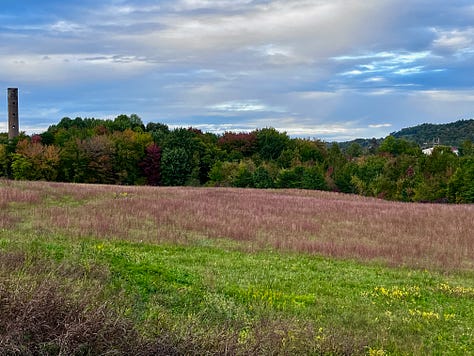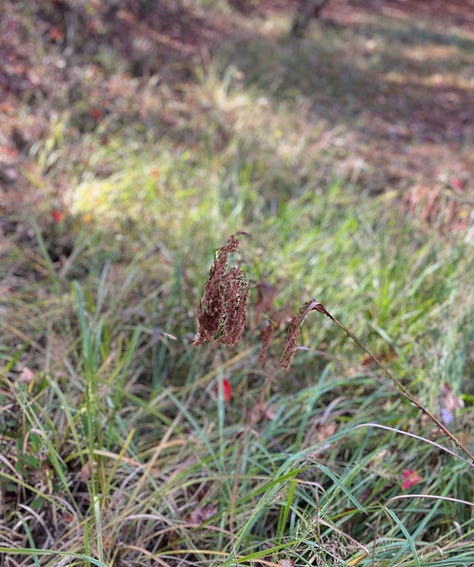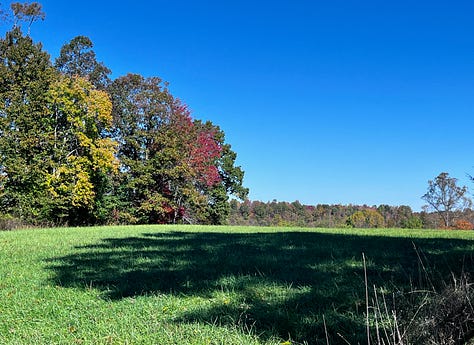That time of year
As so often happens, Ruth said it as well or better than I’m about to: “Color is so much a part of our life that most of the time we accept it without a thought. But in autumn the rapidly changing colors are so spectacular, we can’t help but observe them with astonishment and appreciation — that sets the stage for our acceptance of the coming season” (“Rural Reflections” 14 October 1990).
I had to drive to Knoxville a couple of days ago, which entails driving over Jellico Mountain. For once, the drive went smoothly, as long as you don’t count my frequent urges to just stop and gape at all flame-colored beauty. From the top of the mountain, trees stretch as far as you can see on every side. I did not stop, not wanting to get run over by a snowbird’s RV or a barreling semi, but I did snatch as many glimpses as I could.
As I drove, I started to wonder when peak color is supposed to happen in our part of Appalachia, though when I think about it, I don’t think it’s a date I’ve ever paid much mind to. I’ve lived most of life in rural areas in four-season climates (even if those four seasons are getting increasingly discombobulated), and so the colors of fall have for me a familiarity that teeters on that dangerous edge between appreciation and complacency.
Something I noticed almost immediately when I started sorting through Ruth’s writing is that she was a careful observer of certain seasons and times of year, sometimes even particular months, with two recurring favorites being June and October. I share with her this love of in-between times, though in Kentucky my June is more like May, since by June it often feels like we are full-on into summer, and my Octobers don’t feature snow as often as hers did (for which I am grateful).
I suspect that this close attention to detail has everything to do with being both a writer and a farmer. On the one hand, writers notice their surroundings both by training and by their very nature; on the other, no one can successfully run a farm without keeping a close eye, ear, nose, and the occasional arthritic joint on the environment and the weather.
I’ve shared bits and pieces of Ruth’s columns about October before. Today, I decided to try something different that proved to be equal parts challenging and fun. I pulled up all Ruth’s writings about October side-by-side, copied out lines I particularly liked, then played with reorganizing them until they formed a kind of cento, which is basically a poem made up of lines from someone else’s work.
No, I am not a poet, and no, a newspaper column is not poetry, but in Ruth’s hands it sometimes reads like one. Take, for example, October 21, 2001 where she uses the anaphora “It is mid-October,” which I adopted as a frame for the experiment that follows. Like that phrase, all lines are taken from columns about October from either the early 1990s or 2001. Although I had to make slight changes such as tenses or pronouns to ensure clarity, the lines are all hers. They just show up here in a new form.



Mid-October: An Experiment with Cento
It is mid-October.
At no other time am I so conscious of color. The sumac has never been a brighter red than it is this year. A single maple stands clothed in scarlet.
A purple and a yellow pansy bloom in the nearby flowerbed — a spot of color amongst the dead leaves. They refuse to succumb to the changing seasons as long as possible, and I admire their stamina.
A gray squirrel scratches among the dead leaves, scoops up some morsel, and then sits up to devour his gourmet meal.
I remember how a granddaughter and her grandfather carved her very first jack-o-lantern from a carefully chosen pumpkin.
It continues to get dark earlier and earlier and we turn the lights on long before evening begins. Soon we will be given back that hour that we “lost” last spring.
It is mid-October.
I sputter about it getting dark so early. It will take some time before most of us get “on schedule.”
The jack o’lantern sits on the rail of the back porch, greeting visitors with its strange smile. This morning of early snow the pumpkin’s eyes, nose and mouth are all outlined with white.
I see an empty squirrel nest hanging from the branches of one of the trees now bare along the hedge row.
The field of goldenrod blossoms was covered with white snow, a strange but beautiful sight for October. The bedroom windows are bright with the hanging baskets of impatiens and begonias that I brought in earlier.
Many of the trees are stripped of their leaves and the bare branches form patterns that mark the scene. Perhaps it is all part of a greater plan — this surfeit of color before our world turns gray and brown.
It is mid-October.





loved reading your cento!
Thank you!